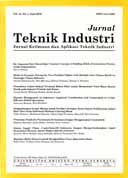Incorporating Cannibalization into Pricing Optimization Using Choice Data: An Application to the Pricing of Mobile Broadband Services
DOI:
https://doi.org/10.9744/jti.21.2.57-68Keywords:
cannibalization, pricing optimization, choice data, hierarchical Bayes, randomized first choiceAbstract
Price differentiation may not be as effective in increasing profitability due to imperfect segmentation, arbitrage, and, cannibalization. Cannibalization takes place when customer with higher willingness-to-pay buys lower-priced product. This research proposes an approach to incorporating cannibalization into pricing optimization using choice data. From choice data, individual level utilities are estimated using hierarchical Bayes and individual choice is predicted using randomized first choice simulation. Individual choices are then aggregated to obtain the demand function. The novelty of this research is in the way cannibalization is incorporated into the pricing optimization. Instead of integrating cannibalization into the demand function or representing it as a separate component in the optimization formulation, in this research, cannibalizing products are incorporated into the simulation scenario as competing products, based on which the demand functions used in the optimization are derived. This approach is more direct and realistic than those in the previous research. The approach was implemented in a case study of mobile broadband services in Indonesian price-sensitive market. The result shows that two-fare-class price differentiation incoporated with product differentiation increases total contribution of about 60% compared to single-fare-class policy. Furthermore, it is also shown from our case study that starting from a three-fare-class policy, through iterations, our approach suggests that policy with two-fare-class results in a not significantly different total contribution.Downloads
References
Ahmadi, A., Olshevsky, A., Parrilo, P. A., and Tsitsiklis, J. N., NP-hardness of Deciding Convexity of Quartic Polynomials and Related Problems, Mathematical Programming, 137(1-2), 2013, pp. 453-376.
Albuquerque, P., and Bronnenberg, B. J., Estimating Demand Heterogeneity Using Aggregated Data: An Application to the Frosen Pizza Category, Marketing Science 28(2), 2009, pp.356-372.
Allenby, G. M., Arora, N., and Ginter, J. L., Incorporating Prior Knowledge into the Analysis of Conjoint Studies, Journal of Marketing Research 32(2), 1995, pp.152-162.
Allenby, G. M., and Ginter, J. L., Using Extremes to Design Products and Segment Markets, Journal of Marketing Research 32(4), 1995, pp.392-403.
Carpenter, G. S., and Hanssens, D., M., Market Expansion, Cannibalisation, and International Airline Pricing Strategy, International Journal of Forecasting 10, 1994, pp.313-326.
Guo, Z. and Chen, J., Multi-Generation Product Diffusion in the Presence of Strategic Customers, Information Systems Research 29(1), 2018, pp.206-224.
Haynes, M., Thompson, S., and Wright, P. W., New Model Introductions, Cannibalization and Market Stealing: Evidence from shopbot data, Manchester School 82(4), 2014, pp.385-408.
Heerde, H. J. v., Srinivasan, S., Dekimpe, M. G., Estimating Cannibalization Rates for Pioneering Innovations, Marketing Science 29(6), November-December 2010, pp. 1024-1039.
Huang, J., Leng, M., and Parlat, M., Demand Functions in Decision Modeling: A Comprehensive Survey and Research Directions, Decision Sciences, 44(3), 2013, pp. 557-609.
Huber, J., Orme, B., & Miller, R., Dealing with Product Similarity in Conjoint Simulations. In A. Gustafsson, A. Herrmann & F. Huber (Eds.), Conjoint Measurement: Methods and Applications (4th ed.), Springer, 2007, pp. 347–362.
Lomax, W., Hammond, K., East, R., and Clemente, M., The Measurement of Cannibalization, Journal of Product & Brand Management 6(1), 1997, pp.27-39.
Louviere, J. J., Flynn, T. N., and Carson, R. T., Discrete Choice Experiments Are Not Conjoint Analysis, Journal of Choice Modeling 3(3), 2010, pp.57-72.
McFadden, D., Modelling the Choice of Residential Location. In: Snickars, F., Weibull, J. (Eds.), Spatial Interaction Theory and Planning Models. North-Holland, 1978, pp.72-77.
Meredith, L., and Maki, D., Product Cannibalizaton and the Role of Prices, Applied Economics 33, 2001, pp.1785-1793.
Ngwe, D., Why Outlet Stores Exist: Averting Cannibalization in Product Line Extensions, Marketing Science 36(4), 2017, pp.524-541.
Pacras, J., Sriram, S., and Kumar, V., Empirical Investigation of Retail Expansion and Cannibalization in a Dynamic Environment, Management Science 58(11), 2012, pp.2001-2018.
Phillips, R. L., Pricing and Revenue Optimization, Stanford University Press, Stanford, 2005.
Pratikto, F. R., Uncapacitated Pricing Optimization for Mobile Broadband Services, Jurnal Teknik Industri 20(1), June 2018, pp. 49-58.
Reimers, I., and Xie, C., Do Coupons Expand or Cannibalize Revenue? Evidence from an e-Market. Management Science 65(1), January 2019, pp. 286-300.
Sawtooth Software, The CBC/HB System for Hierarchical Bayes EstimationVersion 5.0 Technical Paper, Technical Paper Series, 2009.
Srinivasan, S. R., Ramakrishnan, S., and Grasman, S. E., Incorporating cannibalization models into demand forecasting, Marketing Intelligence & Planning 23(5), 2005, pp.470-485.
Susanta, L. N., Usulan Penetapan Harga untuk Paket Mobile Internet Telkomsel Flash Berdasarkan Choise-Based Conjoint Analysis, Final Project, Department of Industrial Engineering, Parahyangan Catholic University, 2013.
Train, K. E., Discrete Choice Methods with Simulation, 2nd edition, Cambridge University Press, 2009.
Wolberg, G. and Alfy, I., An Energy-Minimization Framework for Monotonic Cubic Spline Interpolation, Journal of Computational and Applied Mathematics, 143, 2002, pp. 145-188.
Downloads
Published
How to Cite
Issue
Section
License
Articles published in the Jurnal Teknik Industri: Jurnal Keilmuan dan Aplikasi Teknik Industri will be Open-Access articles distributed under the terms and conditions of the Creative Commons Attribution License (CC BY).
![]()
This work is licensed under a Creative Commons Attribution License (CC BY).



















